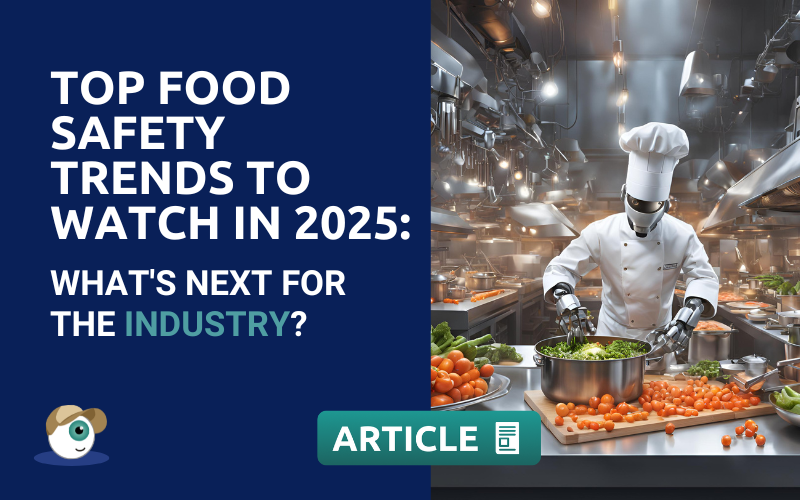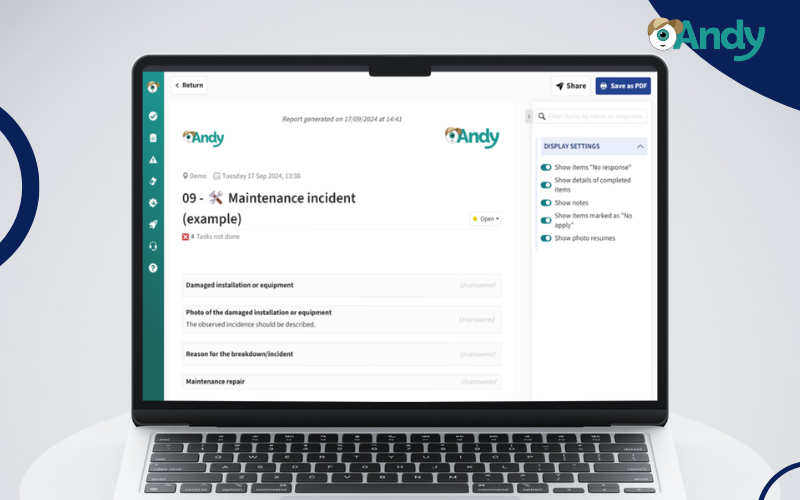Top Food Safety Trends to Watch in 2025: What’s Next for the Industry?

The year 2025 is set to bring significant advancements in food safety practices driven by new technologies, regulatory changes, and consumer demands.
Ensuring the highest standards of food safety is more critical than ever as the industry faces challenges like supply chain disruptions, evolving pathogens, and sustainability pressures.
Here’s a look at the top food safety trends that are expected to shape the industry in 2025.
Top Food Safety Trends in 2025 for the Food Service Industry
Food Safety Trend 1/ AI in Food Safety
Artificial intelligence (AI) and automation are transforming food safety protocols.
By 2025, expect to see more AI-powered solutions for monitoring and managing food safety in real-time. These systems can quickly identify contamination risks, analyse large datasets to predict potential hazards, and even optimise cleaning schedules for equipment.
For example, AI-driven technologies are now being leveraged to automate the inspection of food products, ensuring they meet stringent safety standards without the need for human oversight. This not only reduces the margin for error but also accelerates the quality assurance process significantly.
Industry experts predict that automation and AI will play a pivotal role in enhancing the efficiency and accuracy of food safety management systems across the entire supply chain.
By adopting these technologies, businesses can improve compliance, reduce waste, and ensure safer food handling practices, ultimately contributing to a more resilient and responsive food industry.
Food Safety Trend 2/ Blockchain for Traceability and Transparency
Blockchain technology is gaining momentum in the food industry as a tool for enhancing traceability. By using blockchain, companies can maintain transparent and tamper-proof records of their food products from farm to table. This technology is particularly effective in tracking the origin of raw materials, which helps in quick identification and response to food safety incidents.
The World Health Organization (WHO) has highlighted the importance of robust food safety systems, noting that blockchain can help ensure compliance with new regulations and build consumer trust by providing clear visibility into the food supply chain.
By 2025, more companies are expected to adopt blockchain to streamline their compliance with food safety standards.
Food Safety Trend 3/ Increased Focus on Allergen Management
Food allergies are a growing concern globally, with more consumers seeking transparency around allergens in their food.
As a result, food manufacturers are prioritising the prevention of cross-contamination and improving labelling practices.
By 2025, new allergen detection technologies, including rapid testing kits and automated labelling systems, will become more prevalent.
These advancements are driven by the rising consumer demand for allergen-free products and stricter government regulations. Companies investing in advanced allergen management systems will not only be enhancing consumer safety but also gaining a considerable competitive edge.
Food Safety Trend 4/ Emphasis on Sustainable Food Safety Practices
Sustainability is no longer just a buzzword; it’s becoming a core aspect of food safety.
In 2025, we can expect a shift towards sustainable sourcing, packaging, and waste management. Companies are increasingly adopting eco-friendly practices to align with both regulatory standards and consumer expectations for environmentally responsible products.
For example, initiatives such as reducing single-use plastics, utilising biodegradable packaging, and cutting down on food waste are becoming part of food safety protocols. The push for sustainability is also reflected in the adoption of regenerative agriculture practices, which not only improve soil health but also enhance the safety of food products.
Food Safety Trend 5/ Personalised Nutrition and Food Safety
With the rise of personalised nutrition, food safety is becoming more tailored to individual dietary needs. Technologies that track dietary preferences, allergens, and nutritional requirements are driving the development of personalised food products. By 2025, the integration of data from wearable devices and health apps into food safety management will be more common, allowing for customised safety measures that cater to specific consumer profiles.
According to a recent study, personalised nutrition solutions will continue to grow, particularly in addressing specific health conditions like diabetes, heart disease, and gut health. Companies that embrace this trend can enhance their food safety protocols by offering more personalised and safer food options.
Food Safety Trend 6/ Regulatory Changes and Compliance
The regulatory landscape is evolving, with new food safety standards being introduced globally.
For instance, the U.S. Food and Drug Administration (FDA) has been updating its guidelines to address emerging risks, including new rules for produce safety and foreign supplier verification. By 2025, companies will need to stay ahead of these regulatory changes to avoid penalties and protect their brand reputation.
One significant change on the horizon is the rollout of the FDA’s New Era of Smarter Food Safety Blueprint, which focuses on leveraging technology to create safer food systems. This initiative emphasizes traceability, digital tools, and data analytics to prevent foodborne illnesses.
Food Safety Trend 7/ Rise of Plant-Based and Lab-Grown Foods
The surge in plant-based and lab-grown foods also presents unique food safety challenges. These products often require different handling and processing techniques compared to traditional animal-based foods. In response, new safety protocols are being developed to address potential risks associated with alternative proteins, including microbial contamination and shelf-life management.
As the market for plant-based foods grows, driven by health and environmental concerns, food safety practices will need to evolve to keep pace with innovation. The adoption of new testing methods and safety standards for these products will be critical in ensuring consumer confidence.
Food Safety Trend 8/ Proactive Food Safety Management with Andy Digital Food Safety Software
One of the most exciting developments in food safety for 2025 is the consolidation of digital food safety assistants like our Andy.

Helpful, smart and always alert, Andy provides unprecedented control and standardisation across all kitchen operations, transforming how food safety protocols are managed in real-time.
Andy can automate critical HACCP and hygiene checks, food labelling, auditing, monitor compliance, and streamline reporting.
For example, Andy can automatically track temperatures, manage hygiene protocols, and maintain detailed records of food storage and handling – all while eliminating the reliance on manual inspections.
This not only ensures compliance with stringent food safety regulations but also minimises the risk of human error, which is a common cause of food safety breaches.
Moreover, Andy can enhance traceability by providing a transparent record of the entire food preparation process. From ingredient sourcing to the final dish, Andy ensures that every step adheres to safety standards, thereby boosting consumer confidence and trust. The ability to collect and analyse data continuously also allows these systems to predict potential issues before they arise, enabling a proactive approach to food safety.
Adopting a digital food safety assistant like Andy in your kitchen not only ensures absolute control over operations but also supports sustainability by reducing food waste and optimising resources. As the food industry moves towards greater automation and digitalisation, having a tool like Andy can give businesses a competitive edge, helping them stay ahead of evolving food safety demands and standards.
The landscape of food safety trends in 2025 is set to be defined by technological advancements, regulatory shifts, and consumer-driven demands for transparency and sustainability. Companies that proactively adapt to these trends will not only enhance their safety protocols but also strengthen their market position.
Staying informed and investing in the latest food safety technologies will be key for businesses looking to thrive in this rapidly changing industry.
It is clear that, as the industry moves forward, the focus will remain on leveraging technology to create safer, more sustainable, and personalised food experiences for all.
👉🏽START YOUR JOURNEY INTO FOOD SAFETY AUTOMATION
BY TRYING ANDY TODAY 👈🏽


